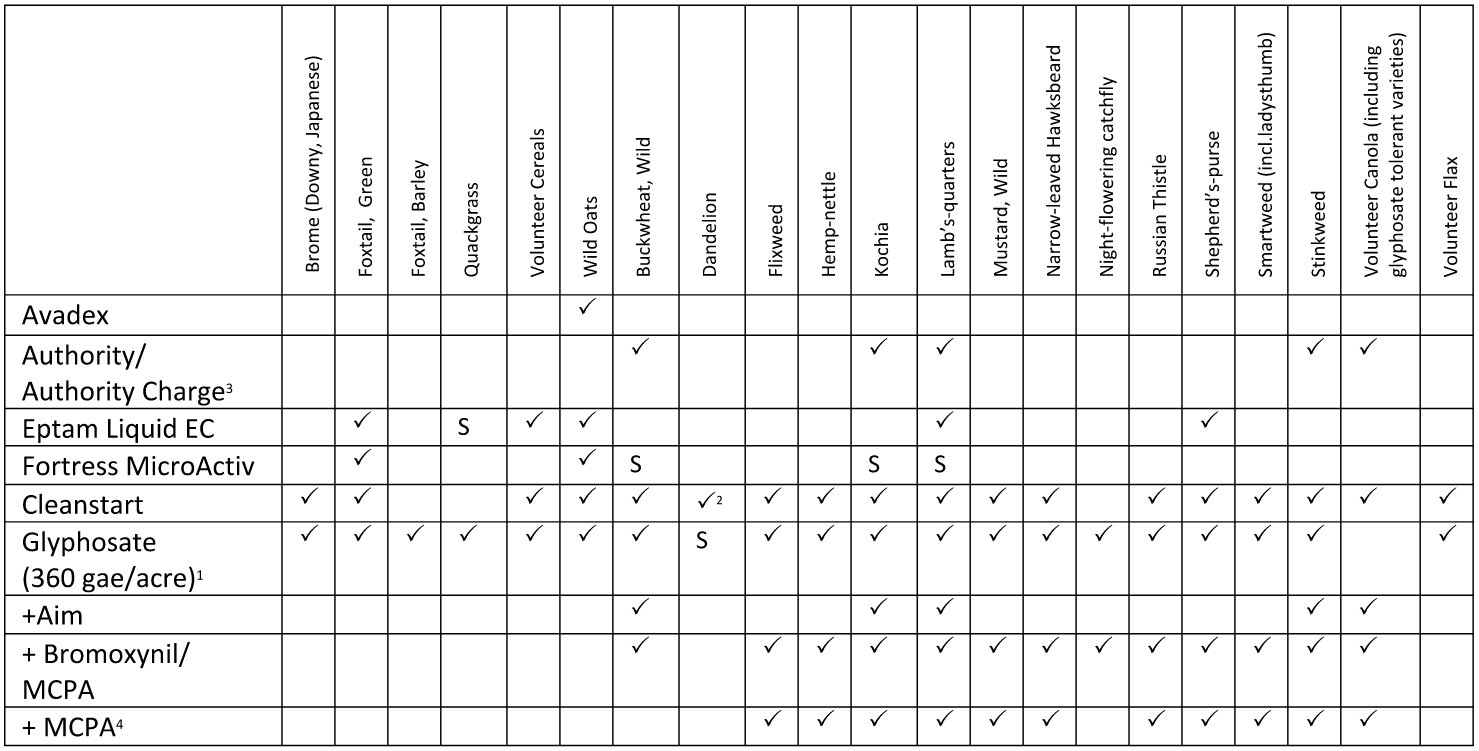Flax TIPS: Getting off to a good start: Quick tips for successful flax stand
1. Field preparations
-
Flax is small-seeded so measures should be taken to ensure the field is well prepared to promote good soil-to-seed contact and emergence.
-
Bunched straw may reduce plant populations by impeding emergence. Low plant stands contribute to low yields and increased weed pressure.
-
Loose or clumping seed beds may reduce seed-to-soil contact.
2. Early season weed control
-
Flax is a very poor competitor with weeds.
-
Early season weed control gives the crop a head start and better enables it to compete with later emerging weeds.
Table 1. Pre-seed or pre-emergent herbicide options in flax.
Control. S – Suppression. + Indicates registered tank mix partner with glyphosate. 1 Rates of application varies among brands. Consult the product page for application rates. 2Spring seedlings only. 3 Initial burndown only. For extended in season control see Authority Charge label for in crop weeds. 4 Up to 200 gae/acre; Amine formulations only. Note: Some products may have additional weeds on the label. Check label for complete list. Adapted from the Saskatchewan/Manitoba Guide to Crop Protection.
3. Seed treatments
-
Seed treatments are shown to increase seedling survival (flax typically assumes 50 – 60%) by resisting soil and seed borne pathogens. Link to research click here
-
However, no statistically significant benefits in yield have been shown by research on various seed treatments.
-
Can be advantageous when coping with poor seeding conditions (e.g. cold, water-logged, tight rotations, heavy soils, compaction, history of seedling blights/ root rots in other crops), particularly since flax seems to benefit from having a vigorous start.
-
Follow label instructions for successful applications.
4. Fertilizer applications
-
Flax is sensitive to seed placed nitrogen and phosphorus.
-
No nitrogen should be placed with the seed.
-
Nitrogen rates should target 30 – 35 bu/ac yield target.
-
Studies have found little difference in side-band vs. mid-row band. Other studies have shown benefits to placing below the seed.
-
Flax may be a good candidate for split-applications due to N sensitivity and since it can be susceptible to mid-season N deficiencies.
-
Up to 15 lbs P2 O5 / acre could be applied with the seed. Banding is also the preferred placement for phosphorus.
5. Seeding date
-
Flax is fairly resilient to seeding date; ideally it should be planted in the first 3 weeks of May.
-
Flax is tolerant to frost.
-
Emerging (cotyledon stage) plants can tolerate up to approximately -3° Celsius.
-
Two leaf stage can tolerate up to approximately -8°C for a short time, if hardened first.
-
-
Flax requires 95 – 125 days to maturity, which may warrant earlier seeding dates in some regions.
-
Seeding in early May as opposed to late May has been shown to help manage disease by avoiding humid conditions later in the growing season.
6. Seeding rate and depth
-
Seeding rates should target 30 – 40 plants/ sq. ft.
-
If using farm saved seed, a seed sample should be sent to an accredited seed lab to verify that it is free from CDC Triffid and the germination/ vigour potential. A list of labs can be found here (link to: https://csi-ics.com/accredited-labs)
-
Seed that was stored that was tough or damp is more prone to a deterioration of quality.
-
Using germination (%) when calculating seeding rate permits compensation for poorer quality seed.
-
Flax is small seeded and should be seeded at approximately 1” seeding depth. Adequate soil moisture should be conducive this spring.
-
Check fan speeds to make sure flax seeds are not cracking, which causes reduced germination and plant stands that can decrease yields and competitiveness with weeds.
For more information on best management practices, visit https://archive.flaxcouncil.ca/newsroom/tips_article/.




